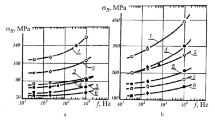Abstract
The relationship between the cyclic life and reduced stress in half-cycles of heating (compression) has been established, as well as the parameters defining the transition from the quasi-static to fatigue fracture mode and their threshold values. An approach has been proposed for the evaluation of cyclic life under thermal fatigue, which involves a preliminary prediction of the fracture mode and the use of calculation relationships corresponding to the predicted mode of fracture.
Similar content being viewed by others
References
A. P. Gopkalo, “An investigation of the features of loading in thermal fatigue,” Strength Mater., 26, No. 10, 725–728 (1994).
V. T. Troshchenko, D. P. Sinyavskii, and A. P. Gopkalo, “Fracture criteria for metals under nonisothermal loading. Report No. 2,” Strength Mater., 13, No. 12, 1450–1455 (1981).
A. P. Gopkalo and D. P. Sinyavskii, “On life prediction for structures operating under conditions of cyclic temperature variations,” in: Reliability and Durability of Machines and Structures [in Russian], Issue 2, Kiev (1982), pp. 40–45.
L. F. Coffin, “On the thermal fatigue of steels,” in: Heat-Resistant Alloys under Conditions of Varying Temperatures and Stresses [Russian translation], Gosenergoizdat, Moscow (1960), pp. 188–258.
S. S. Manson, “Fatigue: A complex subject-some simple approximations,” Exp. Neck., 5, No. 7, 193–226 (1965).
S. S. Manson and G. R. Halford, “A method of estimating high-temperature low-cycle fatigue behavior of materials,” in: Proc. Int. Conf. on Thermal and High-Strain Fatigue, Metals and Metallurgy Trust, London (1967), pp. 254–270.
S. Taira, “Lifetime of structures subjected to varying load and temperature,” in: N. J. Hoff (Ed.), Creep in Structures, Academic Press, New York (1962), pp. 96–124.
S. S. Manson, G. R. Halford, and M. H. Hirschberg, “Creep-fatigue analysis by strain-range partitioning,” in: Proc. Symp. on Design for Elevated Temperature Environment, ASME (1971), pp. 12–28 (NASA TM X-67838, 1971).
R. A. Dul'nev, “Summation of static and cyclic effects on strength during thermocyclic loading,” Strength Mater., 3, No. 10, 1234–1237 (1971).
V. T. Troshchenko, D. P. Sinyavskii, and A. P. Gopkalo, “Fracture criteria for metals under nonisothermal loading. Report No. 1,” Strength Mater., 13, No. 12, 1445–1449 (1981).
V. A. Strizhalo, “Study on the regularities of the transition from quasistatic to fatigue rupture of light alloys under a few load cycles,” Strength Mater., 6, No. 5, 567–573 (1974).
V. A. Strizhalo, Cyclic Strength and Creep of Metals under Low-Cycle Loading at Low and High Temperatures [in Russian], Naukova Dumka, Kiev (1978).
Author information
Authors and Affiliations
Additional information
__________
Translated from Problemy Prochnosti, No. 1, pp. 95–104, January–February, 2009.
Rights and permissions
About this article
Cite this article
Gopkalo, A.P. Evaluation of the limit state and cyclic life of structural materials under thermal fatigue. Strength Mater 41, 74–80 (2009). https://doi.org/10.1007/s11223-009-9101-z
Received:
Published:
Issue Date:
DOI: https://doi.org/10.1007/s11223-009-9101-z




